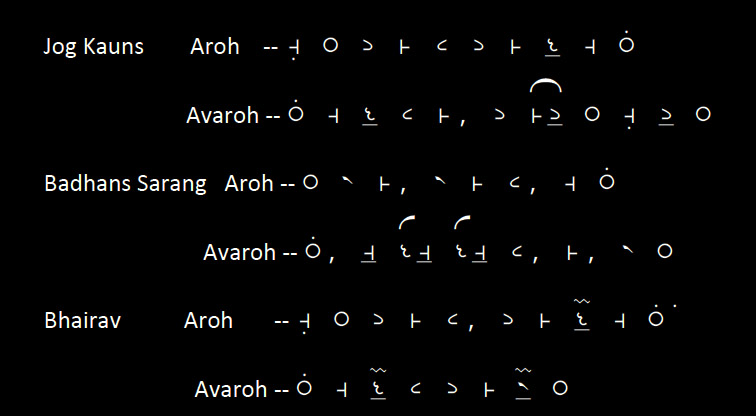Ome Swarlipi Notations in Tweets

Ome Swarlipi Notations in Tweets |

|
By Dr Santosh Pathak |
With increasing numbers of ICM learners consulting the Raga bank tweets, the abridged expression requires background information to make full use of tweets.
Users may follow the twitter account @Ragaswar or open the link directly in browser: http://twitter.com/Ragaswar. The account makes one tweet every day about the notes of a particular Raga. The tweet is a helpful way to improve one’s skill in writing Ome Swarlipi notations, apart from gaining familiarity with notes of Raga-s. While to most formal learners, it is clear that ascending and descending notes --- Aroh and Avaroh -- are indicative and sometimes may be expressed with greater elaboration and finesse, some early learners may take them as ultimate expressions.
The limitation of format poses challenge and therefore some elaborate phrases have to be expressed in abridged or root form. Despite this, the tweets score over the text-book full form introductions to Raga by providing a quick glimpse into the genre of Indian Classical Music. The benefits of the Raga Tweet may be stated thus:
Introduction and primary acquaintance with Raga-notes, the Raga-Swar.
Visual understanding of inter-relationship and movement of notes in Aroh and Avaroh
Digital compendium of Raga-s, which can be curated using readers like Flipboard on portable device for quick reference.
Using the Raga notations from a tweet for writing full composition with Ome Swarlipi Writer on http://beta.omescribe.com/
Ome Swarlipi is designed to be a universal representation of music. Rooted in Indian tradition, the technique allows for notation of notes, strokes and beats in a compact, expressive manner suited both to print and digital publication. The seven notes are keyed in using small letters, the five variants – four flat and one sharp – in capital letters. The dot (.) mark above letter symbolizes upper (Tar) octave, below the letter, it indicates note in the lower octave. The Tar is keyed in by writing ‘u’ after the note-letter. Mandra is expressed with letter ‘l’ after note-letter.
nl denotes Nishad of lower octave, Nl denotes flat or Komal Nishad in the Mandra.
su denotes Tar Shadja or Shadja in Upper octave, Ru indicates Tar Komal Rishabh.
The slide, Glissando or Meend holds an important place in Indian music. Only in some Raga-s, the tweets from @Ragaswar include Meend and other characteristic expressions as Kan, Krintan, Murki. The full explanation of these are given in the Reference section of Omescribe -- http://omescribe.com/help/ . They are briefly being described to enable understanding tweets and writing compositions in digital notation.
Meend: The slide is from one to two or more notes. At times during a long glide a stroke is taken mid-point. The letters q, w, e are used to start Meend (q before the note letter), continue (w), indicate stroke (W before note-letter) and end Meend (e before note-letter). For example the tweet about Raga JogKauns would use Meend to connect Madhyam (m) and Flat Gandhar (G) using start-pointer q and end-marker e.
Jog Kauns Aroh -- nl s g m p g m D n su Avraroh -- su n D p m, g qmeG s nl G s
Kan: Kan is defined as shadow note which gently touches given note. While in regular notations written using Ome Swarlipi Writer, it is expressed with shadow note in superscript preceding main note, for simple expression in a tweet it is written with ‘q’ followed by shadow note and main note with no space between any of the letters. So, in Avaroh of Badhans Sarang keying in qdN would indicate Kan of Dhaivat in main note Komal Nishad.
Badhans Sarang Aroh -- s r m, r m p, n su Avaroh -- su, N qdN qdN p, m, r s
Krintan: By repeating Kan once or more, Krintan is produced. It is expressed in Writer as super-scripted shadow-note followed by vertical lines indicating repetition. It is more decorative than characteristic, hence not used in Raga Aroh or Avaroh.
Gamak: Gamak is a short vibration of note hence it is indicated by a squiggle on top of the note. It is keyed in by writing letter ‘v’ after the note. In Raga Bhairav, Gamak is taken on flat notes, Dhaivat in Aroh and on both Dhaivat and Nishad in Avaroh.
Bhairav: Aroh -- nl s g m p, g m Dv n su Avaroh -- su n Dv p g m Rv s

Murki: Another way of quick note application is Murki. When a base note moves quickly to touch adjoining notes above and below, it is represented in parenthesis. The notes it touches are not written, e.g. the murki of (G) might be taken with first touching Rishabh and then touching Madhyam with Gandhar remaining the main note. In this case, it can indicate two possibilities:
--- r G m G ---; --- m G r G ---
Both of above are representations of Murki of G or Komal Gandhar. In the first case, the artiste chooses first to touch Rishabh and then Madhyam; in the second, he may first touch Madhyam and then Rishabh. This is a personal spontaneous choice of the artiste, hence it is indicated merely as the single main note within parenthesis, (G) in this case.
Twitter is based on brevity. Learners require elaboration in order to understand the nuance of a Raga. It is therefore flawed thought that one can master Raga-s through tweets. Yet, like numerous cogs in a machine, the Raga tweets hold their own significance in discussion of Raga-s. If it achieves nothing else, at least it brings into light the unknown, forgotten and out-of-vogue classical Raga structures.
Reference
Ome Swarlipi: Notation System for Indian Music
Ome Swarlipi: Communicating Complex Music Patterns Paper at Rabindra Bharati University
Suggested:
Bharatiya Sangeet Vadya on wikipedia
Sitar Compositions in Ome Swarlipi Read Review by Pt. Omprakash Chourasiya Order it on Lulu